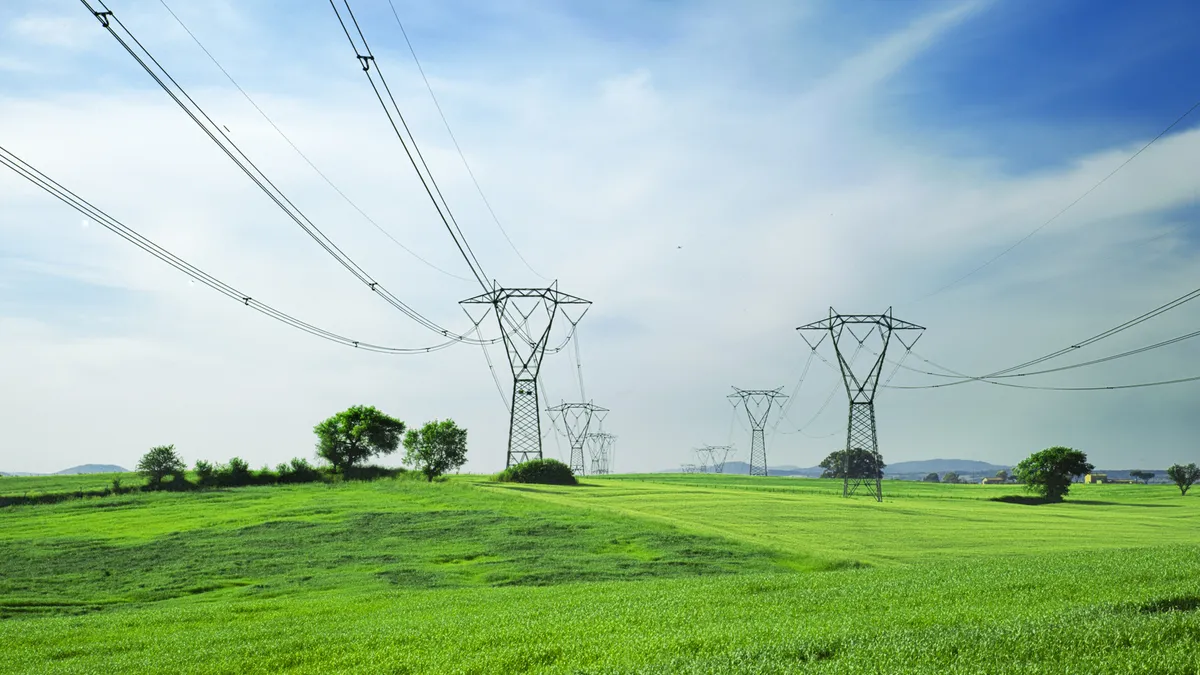Dive Brief:
-
Enabling a transmission investment tax credit (ITC) could spur $15.3 billion in private capital investment, enable an additional 30 GW of renewable energy capacity and create 650,000 "good paying jobs," in the near term according to a report released Thursday.
-
The report, authored by Grid Strategies and commissioned by the American Council on Renewable Energy (ACORE), follows the ITC's inclusion in President Joe Biden's proposed $2 trillion infrastructure plan, and its successive introduction in the House and Senate by Democrats. It received wide-ranging support from environmentalists, labor advocates and developers during a webinar hosted by ACORE Thursday.
- At least 22 high-voltage transmission projects could begin construction in the near term if given a path to cost recovery, according to the report, a potential total investment of $33.3 billion. The report finds that a little less than half of those projects would likely be eligible for the ITC, leading to the approximately $15 billion weighted estimate.
Dive Insight:
Increasing electric transmission capacity is widely acknowledged to be a necessary step toward reaching Biden's goal of bringing the U.S. to a 100% carbon-free power grid by 2035. Doubling U.S. transmission capacity is one of the most cost-effective ways for the U.S. to reach a zero-carbon grid, according to a January study from the Massachusetts Institute of Technology. And a December Princeton study found transmission capacity will need to triple by 2050 for the nation to achieve a net-zero emissions economy.
"Inadequate transmission capacity is absolutely hindering our ability to integrate significant amounts of renewable energy into the grid," said Sen. Martin Heinrich, D-N.M., during the ACORE webinar. Heinrich cosponsored the ITC bill in April, after first introducing it in 2019.
"And that problem is only going to get worse if we don't do something about it. ... The 10 years required just on average to plan and permit transmission lines means that we don't have any time to waste. We need to act now and we need new policy tools like the investment tax credit," he said.
The ITC as it currently stands would apply to transmission projects at or exceeding 275 kilovolts, that could be developed by either merchant or utility developers, and include both alternating current and direct current lines. However, with "remaining permitting risks and the challenge of finding buyers and sellers to purchase capacity," along with unknown final details on the credit design, the report estimates a little less than half of the 22 projects will be eligible in the near term, totaling 4,000 miles of high-capacity lines and creating 650,000 jobs.
"Most people think of the main barrier for transmission to be permitting and siting, since we don't really have a federal regime, unlike gas pipelines," said Gramlich. Although the ITC won't necessarily solve those problems, "there are a bunch of projects that did ... jump over all those hurdles and are basically at, or near, the finish line on that front end, but the general problem with these projects around the country is there's not really a clear path to cost recovery," he said.
Because the lines act as a "public good," it can be difficult to spur private capital to pay for interregional lines, said Gramlich, creating "a perfectly appropriate role for government to come in and fill the void."
Another major benefit of the ITC for transmission is that it is familiar to stakeholders, said Gramlich, making it an easy policy to take advantage of quickly.
"Tax credits ... are well known to the electricity business," he said. "Developers know how to use them, investors know how to finance projects with them — so it's a tried and true tool."
Berkshire Hathaway Energy, Invenergy, the International Brotherhood of Electrical Workers and the Natural Resources Defense Council all joined the webinar in support of the policy. Utility and power provider trade groups did not respond or declined to comment on the report or the proposed bill.
Thus far, only Congressional Democrats have shown interest in the transmission ITC, though a Republican-majority Senate passed extensions for wind and solar tax credits at the end of last year through bipartisan negotiations, and even added one for offshore wind. A spokesperson for Heinrich's office said they were not aware of any Republican cosponsors on the transmission ITC bill.
Heinrich and Rep. Sean Casten, D-Ill., in April also introduced a bill that would direct the Federal Energy Regulatory Commission to tackle interregional transmission planning.
Addressing interregional transmission planning is a priority for some members of FERC, including Chair Richard Glick, Commissioner Allison Clements and Commissioner Neil Chatterjee, though Chatterjee and Glick differ somewhat on how they'd like to see transmission policy addressed. Commissioner Mark Christie has said he's concerned about potential costs of updating transmission policy and aggressively building out more power lines.















